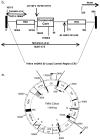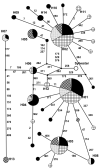Mitochondrial DNA sequencing of cat hair: an informative forensic tool
- PMID: 21077873
- PMCID: PMC3059515
- DOI: 10.1111/j.1556-4029.2010.01592.x
Mitochondrial DNA sequencing of cat hair: an informative forensic tool
Abstract
Approximately 81.7 million cats are in 37.5 million U.S. households. Shed fur can be criminal evidence because of transfer to victims, suspects, and/or their belongings. To improve cat hairs as forensic evidence, the mtDNA control region from single hairs, with and without root tags, was sequenced. A dataset of a 402-bp control region segment from 174 random-bred cats representing four U.S. geographic areas was generated to determine the informativeness of the mtDNA region. Thirty-two mtDNA mitotypes were observed ranging in frequencies from 0.6-27%. Four common types occurred in all populations. Low heteroplasmy, 1.7%, was determined. Unique mitotypes were found in 18 individuals, 10.3% of the population studied. The calculated discrimination power implied that 8.3 of 10 randomly selected individuals can be excluded by this region. The genetic characteristics of the region and the generated dataset support the use of this cat mtDNA region in forensic applications.
2010 American Academy of Forensic Sciences. Published 2010. This article is a U.S. Government work and is in the public domain in the U.S.A.
Figures




References
-
- American Pet Product Manufacturing Association (APPMA) National pet owner’s survey. APPMA; Greenwich, CT: 2006.
-
- American Veterinary Medical Association (AVMA) US pet ownership and demographics sourcebook. American Veterinary Medical Association; Schaumburg, IL: 2007.
-
- Hendricks WH, Tarttelin MF, Moughan PJ. Seasonal hair growth in the adult domestic cat (Felis catus) Comp Biochem Physiol. 1996;116A(1):29–35.
-
- D’Andrea F, Frides F, Coquoz R. Preliminary experiments on the transfer of animal hair during simulated criminal behavior. J Forensic Sci. 1998;43(6):1257–8.
-
- Dachs J, McNaught IJ, Robertson J. The persistence of human scalp hair on clothing fabrics. Forensic Sci Int. 2003;138(1-3):27–36. - PubMed
Publication types
MeSH terms
Substances
Grants and funding
LinkOut - more resources
Full Text Sources
Miscellaneous

